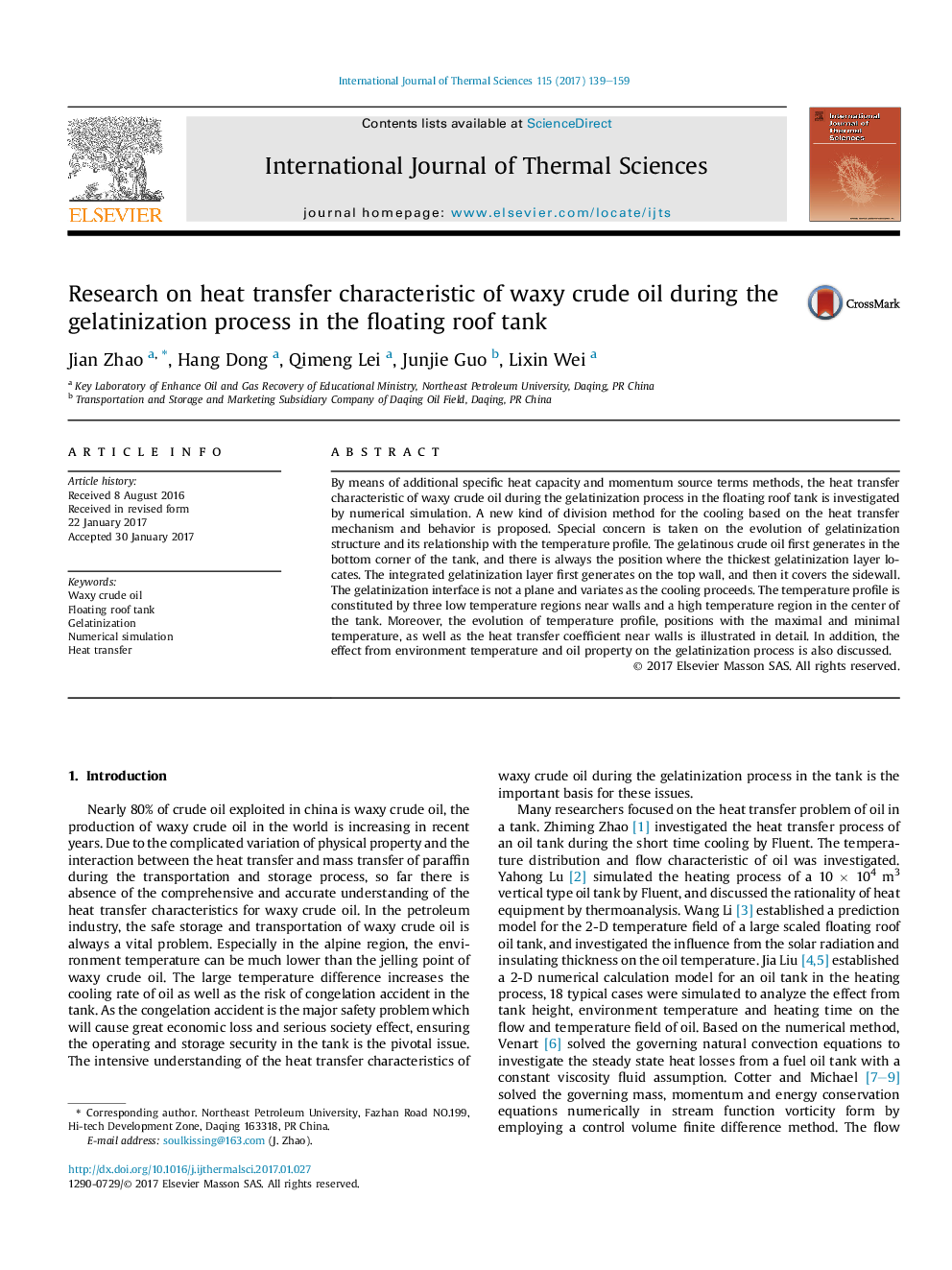| کد مقاله | کد نشریه | سال انتشار | مقاله انگلیسی | نسخه تمام متن |
|---|---|---|---|---|
| 4995312 | 1458707 | 2017 | 21 صفحه PDF | دانلود رایگان |
عنوان انگلیسی مقاله ISI
Research on heat transfer characteristic of waxy crude oil during the gelatinization process in the floating roof tank
ترجمه فارسی عنوان
تحقیق در مورد ویژگی انتقال حرارت ملات نفت خام در طی فرآیند ژلاتین کردن در مخزن سقف شناور
دانلود مقاله + سفارش ترجمه
دانلود مقاله ISI انگلیسی
رایگان برای ایرانیان
کلمات کلیدی
نفت خام موم، مخزن سقفی شناور ژلاتین کردن، شبیه سازی عددی، انتقال گرما،
ترجمه چکیده
با استفاده از ظرفیت حرارتی فوق العاده و اصطلاحات منبع مبسوط، ویژگی انتقال حرارت ملات نفت خام در طول فرآیند ژلاتینی شدن در مخزن سقف شناور با شبیه سازی عددی بررسی می شود. نوع جدیدی از روش تقسیم برای خنک کننده بر اساس مکانیزم انتقال حرارت و رفتار پیشنهاد شده است. نگرانی ویژه در مورد تکامل ساختار ژلاتینیزه و رابطه آن با مشخصات دما مورد توجه قرار گرفته است. نفت خام ژله ای در ابتدا در گوشه پایین مخزن تولید می شود و همیشه موقعیتی است که ضخامت ترین لاک ژلاتین شدن را پیدا می کند. لایه ژلاتین سازی یکپارچه ابتدا بر روی دیوار بالا تولید می شود و سپس آن را پوشش می دهد. رابط ژلاتینیابی یک هواپیما نیست و به عنوان خنک کننده تغییر می کند. مشخصات دما توسط سه منطقه کم دما در نزدیکی دیواره ها و یک منطقه با درجه حرارت بالا در مرکز مخزن تشکیل شده است. علاوه بر این، تکامل مشخصات دما، موقعیت با حداکثر و حداقل دما، و همچنین ضریب انتقال حرارت در نزدیکی دیوارها، به طور دقیق نشان داده شده است. علاوه بر این، اثر دما و خصوصیات روغن بر روی فرایند ژلاتینیزه نیز مورد بحث قرار گرفته است.
موضوعات مرتبط
مهندسی و علوم پایه
مهندسی شیمی
جریان سیال و فرایندهای انتقال
چکیده انگلیسی
By means of additional specific heat capacity and momentum source terms methods, the heat transfer characteristic of waxy crude oil during the gelatinization process in the floating roof tank is investigated by numerical simulation. A new kind of division method for the cooling based on the heat transfer mechanism and behavior is proposed. Special concern is taken on the evolution of gelatinization structure and its relationship with the temperature profile. The gelatinous crude oil first generates in the bottom corner of the tank, and there is always the position where the thickest gelatinization layer locates. The integrated gelatinization layer first generates on the top wall, and then it covers the sidewall. The gelatinization interface is not a plane and variates as the cooling proceeds. The temperature profile is constituted by three low temperature regions near walls and a high temperature region in the center of the tank. Moreover, the evolution of temperature profile, positions with the maximal and minimal temperature, as well as the heat transfer coefficient near walls is illustrated in detail. In addition, the effect from environment temperature and oil property on the gelatinization process is also discussed.
ناشر
Database: Elsevier - ScienceDirect (ساینس دایرکت)
Journal: International Journal of Thermal Sciences - Volume 115, May 2017, Pages 139-159
Journal: International Journal of Thermal Sciences - Volume 115, May 2017, Pages 139-159
نویسندگان
Jian Zhao, Hang Dong, Qimeng Lei, Junjie Guo, Lixin Wei,
